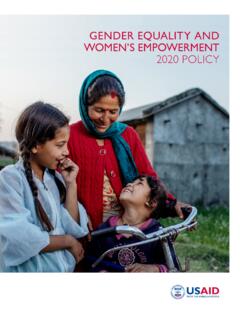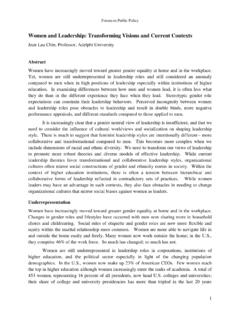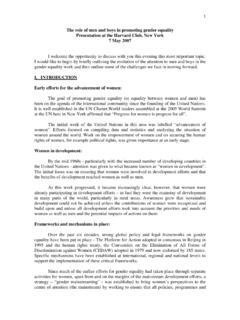Transcription of GENDER EQUALITY INDICATORS - OECD
1 GENDER EQUALITY INDICATORS : WHAT, WHY AND HOW?1. Introduction This practice note focuses on the use of GENDER EQUALITY INDICATORS as a way of measuring change. It asks: what are INDICATORS , and why should we develop INDICATORS to measure GENDER EQUALITY ? It also addresses the often political issue of what we should be measuring, provides some broad principles that can be applied, and suggests some questions donors can ask when developing GENDER EQUALITY INDICATORS . The brief also offers examples of existing INDICATORS noting that they always need to be adapted to specific contexts.
2 What are GENDER EQUALITY INDICATORS '? What are INDICATORS ? INDICATORS are criteria or measures against which changes can be assessed (Imp Act 2005). They may be pointers, facts, numbers, opinions or perceptions used to signify changes in specific conditions or progress towards particular objectives (CIDA, 1997). A GENDER responsive', GENDER sensitive', or GENDER ' indicator measures changes relating to GENDER EQUALITY over time. Such INDICATORS can be quantitative, based on sex disaggregated statistical data which can be measured separately for men and women . Literacy is an example.
3 GENDER EQUALITY INDICATORS can also capture qualitative changes for example, increases in women 's levels of empowerment or in attitudinal changes to GENDER EQUALITY . Measurements of GENDER EQUALITY might address changes in the relations between men and women , the outcomes of a particular policy, programme or activity for women and men, or changes in the status or situation of men and women , such as levels of poverty or participation. 1. Prepared for the DAC Network on GENDER EQUALITY by Justina Demetriades in 2009, based on BRIDGE's GENDER and INDICATORS Cutting Edge Pack (2007), # INDICATORS .
4 The opinions expressed and arguments employed in this paper do not necessarily reflect the official views of the OECD or of its members. 1 Quantitative and qualitative approaches Methodology Working definition Quantitative Quantitative methods of data collection produce quantifiable results. They focus on what can be counted, such as percentages of women and men in parliament, male and female wage rates or school enrolment rates for girls and boys. Quantitative data can show changes in GENDER EQUALITY over time for example, a common quantitative indicator is the number of girls in school compared to boys.
5 Qualitative Qualitative methodologies capture people's experiences, behaviours, opinions, attitudes and feelings for example, women 's experiences of the constraints or advantages of working in the informal sector, or men's and women 's views on the causes and consequences of domestic violence. Participatory methodologies such as focus group discussions and social mapping tools are often used to collect data for qualitative INDICATORS . Qualitative data can also be collected through surveys measuring perceptions and opinions. One example is Program H' which was developed in Latin America to promote more GENDER equitable attitudes among young men (see box below).
6 Program H a partnership of NGOs working with young men Program H uses a GENDER Equitable Attitudes in Men Scale to evaluate attitudinal changes resulting from project activities. INDICATORS were developed to measure changes in attitudes and social norms relating to masculinity. The questions or statements used to evaluate results include affirmations of traditional GENDER norms, such as: Men are always ready to have sex' and There are times when a woman deserves to be beaten', as well as assertions of more GENDER equitable views, such as, A man and a woman should decide together what type of contraceptive to use'.
7 For each indicator, three potential answers are provided: I agree; I. partially agree; I do not agree. This has proven useful for assessing men's current attitudes about the roles of men and women and to measure whether men have changed their attitudes over time (Barker et al 2004). A combination of quantitative and qualitative methods allows data to be compared for cross . checking results. Qualitative interpretation of quantified data can provide for a more nuanced analysis which reduces the possibility of distorted findings and conclusions (see box below). Importantly, qualitative analyses enable us to question why certain patterns have emerged.
8 SDC matrix for assessing qualitative impact data The Swiss Agency for Development and Cooperation (SDC) has developed a matrix to assist the qualitative interpretation of quantitative data. For example, data on the proportion of women and men in parliament can be interrogated further by asking Is there a correlation between the proportion of women candidates who stood for parliament and number of women who actually got in? How does this compare with the situation of men?' (SDC 2006: 31). Participatory methods are effective in gathering relevant data. Participatory methods are based on the principle that men and women should be the agents of their own development.
9 As well as participating in the research, they contribute to decisions about what should be measured and what INDICATORS should be used (see box below). 2 Why look at GENDER EQUALITY and INDICATORS ? What is measured is more likely to be prioritised. Evidence gathered against INDICATORS can also help to make the case that GENDER EQUALITY issues should be taken seriously. INDICATORS can be used for advocacy and can support the case for action by highlighting key issues, backed up with statistics and other evidence. 2. GENDER EQUALITY INDICATORS improve planning and programming.
10 They can be used to evaluate the outcomes of GENDER specific and mainstream interventions and policies and help reveal barriers to achieving success. They can provide vital information for adjusting programmes and activities so that they improve the achievement of GENDER EQUALITY goals and do not create unintended adverse impacts on women or men. They can also be used to measure GENDER mainstreaming within organisations (see section ). GENDER EQUALITY INDICATORS can be used to hold institutions accountable for their commitments. INDICATORS and data can make visible the gaps between the commitments many governments and other institutions have made and their implementation and impact.














